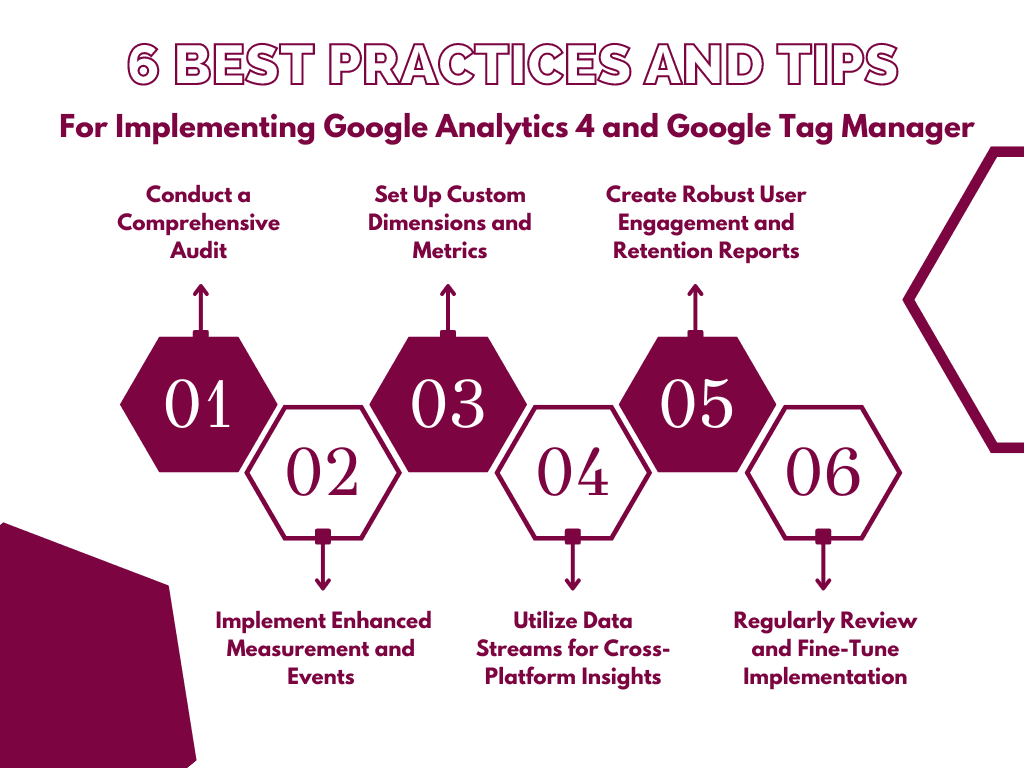Google Tag Manager
Implementing Google Analytics with Tag Manager: 6 Best Practices and Tips
Discover the essential best practices and tips for effectively implementing Google Analytics 4 and Google Tag Manager in your data analytics strategy. Learn how Analytics Safe can help you seamlessly transition from GA3 to GA4 while retaining historical data for data-driven decision-making.
Aug 16, 2023
Introduction
In the ever-evolving landscape of data analytics, businesses face unique challenges with the discontinuation of Google Analytics 3 (GA3) and the introduction of Google Analytics 4 (GA4). As companies shift towards GA4 for data insights, a seamless implementation with Google Tag Manager becomes crucial. This blog presents six best practices and tips to successfully navigate the transition to GA4 and highlights Analytics Safe's specialized solution for preserving historical data during this crucial shift.

6 Best Practices and Tips for Implementing Google Analytics 4 and Google Tag Manager:
1. Conduct a Comprehensive Audit:
Before transitioning to GA4, perform a thorough audit of your current GA3 setup and data. Identify the key metrics and goals that drive your business decisions, and ensure the same data points are tracked in GA4. A well-planned audit will provide a smooth transition without missing essential data.
2. Implement Enhanced Measurement and Events:
GA4 offers Enhanced Measurement, enabling automatic tracking of essential events like page views and scrolls. Take advantage of this feature and implement customized events that align with your business objectives. Leveraging Google Tag Manager, you can effortlessly manage event tracking and enhance data accuracy.
3. Set Up Custom Dimensions and Metrics:
Custom dimensions and metrics are powerful tools to capture specific user interactions and insights unique to your business. Define and set up these custom parameters using Google Tag Manager to gain granular data that drives targeted decision-making.
4. Utilize Data Streams for Cross-Platform Insights:
GA4 introduces Data Streams, allowing you to track data from various platforms like web, mobile apps, and more in a single property. Integrate Google Tag Manager to manage and consolidate these streams efficiently, providing a holistic view of user behavior across different touchpoints.
5. Create Robust User Engagement and Retention Reports:
GA4 emphasizes user engagement and retention metrics, crucial for businesses in the e-commerce, digital marketing, financial services, SaaS, and online education sectors. Leverage Google Tag Manager to track user interactions, analyze retention patterns, and optimize user experiences.
6. Regularly Review and Fine-Tune Implementation:
Data analytics is an iterative process. Continuously review your GA4 and Google Tag Manager setup to ensure data accuracy and relevancy. Regularly fine-tune your tracking and reporting configurations to extract maximum value from your analytics investments.
The Perfect Solution for Preserving Historical Data: Analytics Safe
As businesses face the challenge of transitioning from GA3 to GA4, the need to retain historical data becomes paramount. Analytics Safe, an industry leader in data analytics solutions, offers a unique and tailored offering that seamlessly blends GA3 and GA4 data into a consolidated dashboard. Their team of expert data analysts and engineers specializes in data blending, ensuring businesses retain access to historical data even after GA3 discontinuation.
Analytics Safe's service enables mid-to-large e-commerce businesses, digital marketing agencies, online financial service companies, SaaS companies, and online education platforms to maintain continuity in their data-driven decision-making processes. By adopting Analytics Safe's solution, businesses can smoothly transition to GA4 without losing valuable historical insights, empowering them to make strategic decisions with confidence.
Conclusion:
Implementing Google Analytics 4 and Google Tag Manager requires a strategic approach and adherence to best practices. By conducting a comprehensive audit, leveraging enhanced measurement, setting up custom dimensions, utilizing data streams, and focusing on user engagement and retention reports, businesses can maximize the benefits of GA4. Moreover, Analytics Safe offers the perfect solution to the challenge of preserving historical data, ensuring seamless data-driven decision-making during the transition. Embrace Analytics Safe's expertise to expedite your growth and stay ahead in the dynamic world of data analytics.

